Tulips are among the early spring bloomers, expected to bloom eagerly after long, cold winter months. But, it is very disappointing not to find any sign of tulip flowers in your garden after waiting with high expectations of blooming.
What could be the reasons? Why are your tulips not flowering? Let’s investigate.
Inadequate light, excessive fertilizer, bugs infestation, poor seed quality, and wrong planting location are primary problems due to which your tulips might not be flowering. While you can fix problems like bugs, light, or fertilizer, problems like a poor quality seed or plant have no solution.
In this article, I have compiled a list of the probable causes responsible for no blooms in tulips.
So, if you have recently planted tulips and did not see any bloom in the first spring, read this guide till the end to understand them and fix them as required.
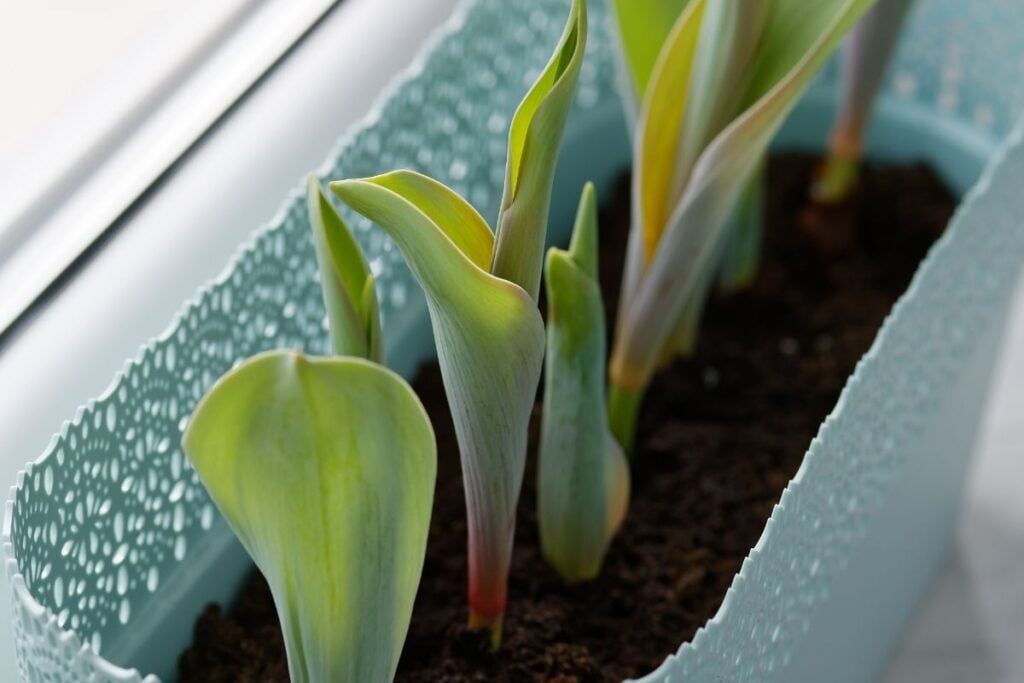
Why are my tulips not flowering?
There is no one particular cause for tulips not flowering. There are many.
Once you go through them, you will realize that the root cause behind tulips is that not flowering can be as prevalent as excess fertilizer or watering or as erratic as pests and animals feeding on the tulip bulbs and the flower buds without your knowledge.
You can also confirm the possible problem you suspect when your tulip doesn’t flower by knowing whether the bulb ever developed anything, if the plant grew any stems and leaves or if there was ever any flower bud.
We will discuss the reasons in detail, along with fixation, so that it becomes easier for you to understand what is wrong with your tulips.
Let’s go through the causes:
Bulb quality
The first thing you should be sure of before planting tulip bulbs is their quality. Healthy tulip bulbs should be fresh and firm and provide a small number of roots at their base. If it feels soft and mushy, they have started rotting.
Before planting bulbs, they need to be chilled for 12-16 weeks in temperatures ranging between 40-45°F. They should not be exposed below 39°F. This will damage the bulbs.
Some growers will proudly explain how they did things suitable for growing tulips and soon witnessed colorful blooms. However, it is good but what exactly matters is the growing conditions.
Maybe your garden’s condition is not ideal for the bulbs like other growers. Maybe the bulbs are not receiving good things. So, these factors are essential for flowering.
When the tulip bulbs don’t show up with any leaves, consider digging them up to inspect their condition and shape. If they are not in good condition or shape, discard them.
Immature bulbs
Your tulips will not flower if you have planted the bulbs before they are matured. A matured bulb is responsible for spring blooms in the first spring after planting.
So you have to wait until the bulb gets matured, and you might see new leaves and even blooms in the second year. In the meanwhile, take care of them and keep checking out for signs of rot or disease.
Other than being matured, some bulbs will not bloom in the first year, but they might bloom in the second year. So, be patient and wait for 2nd-year blooms.
Improper bulb storage
As I mentioned earlier, the tulips bulbs will require chilling before planting to trigger root growth and healthy blooming. When the bulbs are dug up for next year’s flowering, they should be stored in a cold and dark place.
If their storing area is not cool enough, the bulbs will not bloom in the next year.
The same goes for bulbs kept in the ground. Your region should receive enough cold weather so that they can bloom in the coming year. If your region receives a very mild cold, dig up and store the bulbs in the refrigerator.
Another problem arrives when you store the bulbs in the refrigerator. Don’t keep the bulbs along with any fruits. Fruits tend to release ethylene gas which can affect the bulb and prevent them from further blooming.
Bulbs not viable
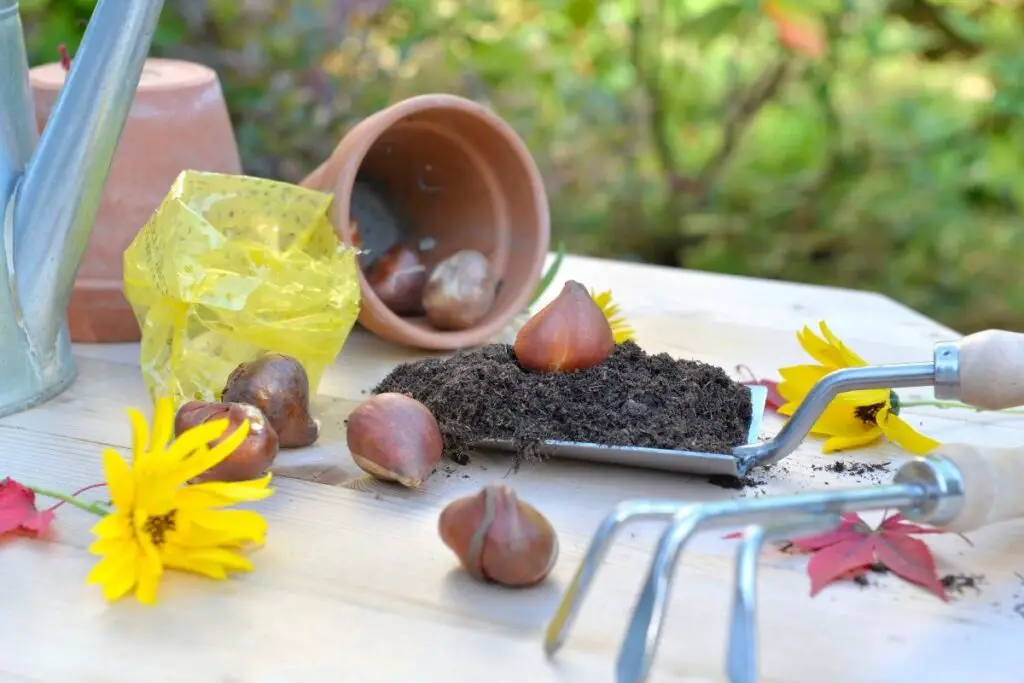
It is difficult to understand and confirm whether a tulip bulb is viable or not. Be cautious and buy bulbs from a guaranteed seller.
But, if you bought it second-hand, cut the bulbs to check whether the bud inside is healthy or not. A healthy flower inside the bulb should look fresh and green.
If the bud inside looks brown and wrinkled, it is not good. These kinds of bulbs are not going to bloom or last longer.
So, in short, firm and big bulbs are the viable ones, and the brown, small, dry, wrinkled, or mushy ones are the wrong bulbs.
Looking for gardening supplies? We have tested 100's of products before recommending them to you guys. Check out our best pick below:
| Image | Gardening Supplies | Best Price? |
|---|---|---|
 Top
Top Top
Top | Raised Garden Bed Kit | Check On Amazon |
 | XLUX Soil Moisture Meter, Plant Water Monitor, Soil Hygrometer Sensor for Gardening, Farming, Indoor and Outdoor Plants, No Batteries Required | No Results |
 Top
Top Top
Top | 82 Pcs Garden Tools Set and Extra Succulent Tools Set | Check On Amazon |
 | Joeys Garden Expandable Garden Hose with 8 Function Hose Nozzle, Lightweight Anti-Kink Flexible Garden Hoses, Extra Strength Fabric with Double Latex Core, (50 FT, Black) | No Results |
 Top
Top Top
Top | Dual Chamber Compost Tumbler | Check On Amazon |
 Top
Top Top
Top | Sunnyglade Plant Stakes | Check On Amazon |
 Top
Top Top
Top | Organic Cold Pressed Neem Seed Oil | Check On Amazon |
 Top
Top Top
Top | Mighty Mint Gallon :-Insect and Pest Control Peppermint Oil | Check On Amazon |
 Top
Top Top
Top | Scotts DiseaseEx Lawn Fungicide | Check On Amazon |
 Top
Top Top
Top | Jacks Classic 20-20-20 All Purpose Fertilizer | Check On Amazon |
 Top
Top Top
Top | 30,000 Seeds Pollinator Attracting Wildflower Mixture | Check On Amazon |
 Top
Top Top
Top | Survival Vegetable Seeds Garden Kit-Over 16,000 Seeds | Check On Amazon |
Site selection
You have planted healthy bulbs and taken care of them well, but still, they don’t flower. The problem might be in the planting site.
When tulips grow in their native land, they receive all their requirements from nature. But in our garden, the growing conditions are quite different from their natural habitat.
We need to be extra careful about it before we plan to grow them.
The problem in your tulip planting site can be either the soil quality sunlight.
Tulips love to grow in loamy and sandy soil, where you will drain out the excess water. A soil with inadequate drainage can damage the bulbs and rot them.
Before planting the bulbs, dig the whole site where you have planned to place the bulbs instead of just digging a small hole. This can improve drainage and aeration.
Add organic ingredients like compost or plant matter to improve the soil structure. You can also add mulch to absorb excess moisture.
If the site is inferior drainage, you might have to transplant your tulip bulbs to another site.
Transplanting the tulips to an ideal location can be risky, but if done at the right time and given all care properly can guarantee the comeback of tulips.
The following vital point for choosing an ideal site is sunlight. Tulips will love to grow under the sun, receiving at least 6 hours of sunlight per day. The warmth of the sun is necessary for tulip flowering.
A good amount of sunlight provides the plant with a lot of energy to photosynthesize and encourage healthy growth, vigorous blooms and get ready for the next year cycle.
Avoid areas where many tall trees or buildings are around as they can block the sunlight from reaching your tulip bed.
Another point I would like to add while choosing a planting site for tulips is its surrounding. Your tulip planting site receiving too cold air or harsh winds will affect the plant’s growth.
Planting tulips close to structures can block the winds, radiate the heat and warm up the soil. It is either good or bad, depending on the late frosts.
Also read: Where Is The Best Place To Plant Tulips? (+Factors To Consider)
Time of planting
The soil temperature is a significant factor for deciding the time of planting the tulips. For tulips, fall is the best time to plant the bulbs. This is the time when soil temperature starts cooling down.
The bulbs need to be chilled for 12-16 weeks to trigger root growth. This will encourage spring blooming.
Planting the bulbs when the soil temperature ranges above 60 degrees Fahrenheit will lead to the rotting of the bulbs. Planting the bulbs when the temperature starts dropping will help develop the root and shoot growth.
An ideal temperature for chilling the tulip bulbs is between 40-50°F.
Also read: When’s The Best Time To Plant Tulips? (+After Plant Care)
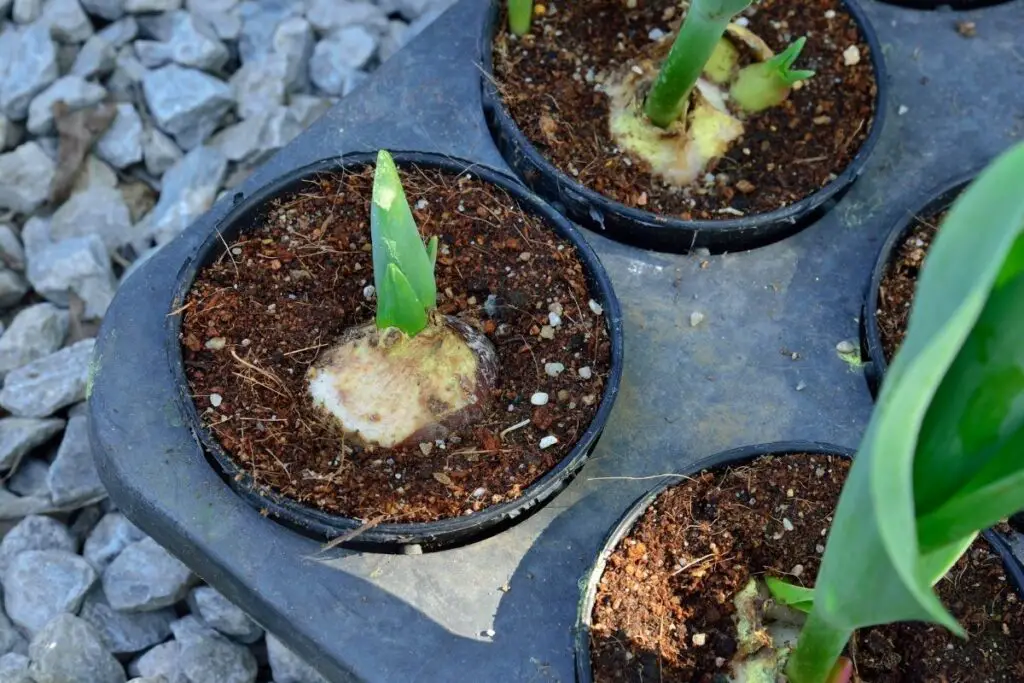
Climate exposures
As I mentioned earlier, the bulbs will rot in warm temperatures, whereas planting them in cold temperatures can help them in healthy root growth and spring flowering. Any interference in this cycle will stop the plant from blooming.
Abnormal warm temperatures can increase the growth rate of tulips, but it will lead to tiny flowers and short vegetation. This will further cause the plant to grow less number of flowers.
A very uncommon cold summer will slow down the growth of flower buds and increase vegetation instead of flower buds.
A late frost in spring will not positively affect vegetation above the ground and slow down the plant’s growth in the next year.
An unfamiliar cold climate can decrease the bulb’s lifespan.
Now, coming to the wet and dry conditions, drought can lead to a lack of moisture in the bulbs. This will affect the health of the flower buds, especially during the hot autumn or winter climate.
Similarly, excessive rainy weather will result in the rotting of the bulbs, especially during the summers, as tulips are dormant in summers.
Also read: What Temperature Do Tulips Need? (+Growing Them At Different Temperature)
Planting depth
The depth of planting the bulbs plays a vital role in prolific tulip flowers.
The bulb should be planted keeping two things in mind – how the bulb will react in extreme climates and at what distance the plant will grow to reach the surface. An ideal planting depth depends on the bulb size.
Generally, a bulb should be planted 3 to 4 inches deep, compared to its height. For example, if the tulip bulb is about 2 inches tall, it should be planted 6 inches below the soil surface.
When the tulips don’t flower, and you suspect that planting depth is responsible, consider checking two things, planted too deep or planted too shallow.
When you plant the bulbs too deep, it becomes weak after a few weeks. Bulbs carry a lot of nutrients the plant uses to grow up the soil surface.
Deep planting will take a lot of time to sprout out and come up to the surface. So, prevent planting bulbs too deep.
When you plant the bulbs too shallow, they are almost on the surface of the soil. Thus these bulbs can get affected by wet soil conditions or cold.
In that case, you can add some organic mulch (fall leaves) during the fall and winter to protect your bulbs.
Also read: When To Plant Tulips Seeds? (How & Guide As Per Your Zone)
Excessive fertilizer
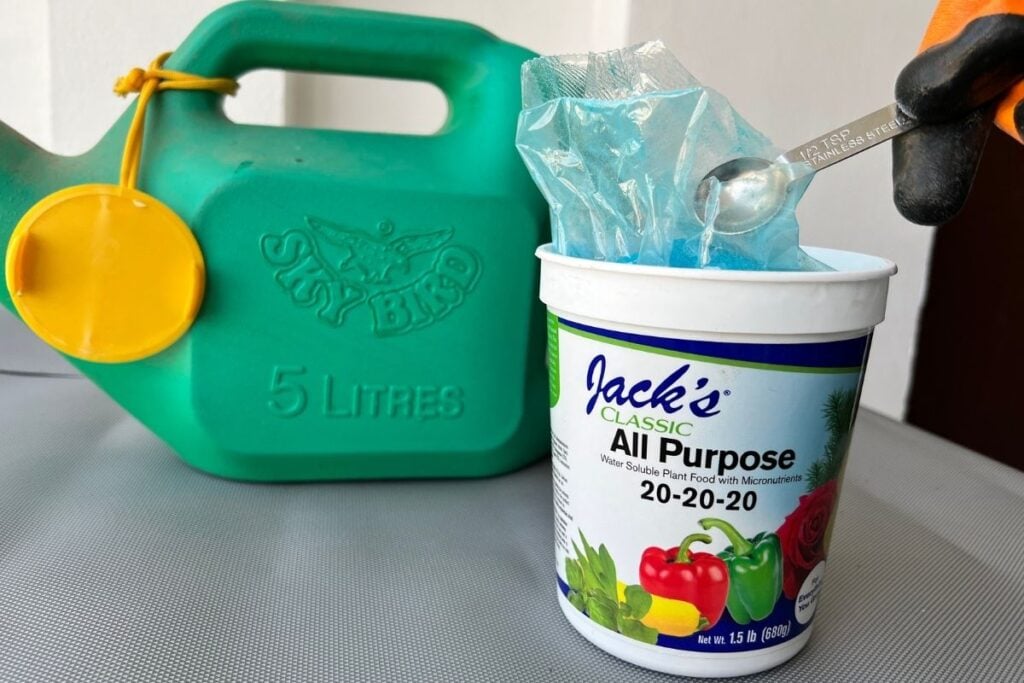
Bulbs already hold a lot of nutrients, and besides, while planting them, the soil mixes too have some ingredients which work like fertilizer. So, it becomes needless to fertilize them again.
You should not fertilize bulbs while flowering; it can cause severe issues like fusarium bulb rot.
Fertilizing them can damage the bulb, affect their growth, and can even kill them. Even if you don’t fertilize the tulips, fertilizer from other resources, like grass, lawn, or other bulbs (if you are growing) can run off to the tulip bed.
Don’t fertilize the tulip bulbs. To prevent run-off, make a raised tulip bed with borders around.
Also read: What Is The Best Fertilizer For Tulips? (Organic+Inorganic)
Overcrowding
When you plant tulip bulbs, they will multiply and fight for air, water, light, and more nutrients at one point.
When the bulbs get overcrowded and packed tight, the plant will not have abundant flowers. In such conditions, you will have to dig up the bulbs and divide them.
When they get overcrowded, it means the current flowering cycle is complete. Keep the baby bulbs. When they mature, they will flower in the next few years.
Also read: Should Tulips Be Planted In Groups? (How To+Care)
Foliage removed early
After the tulips flower, the leaves will start turning brown. It might look tempting to remove the leaves off the plant. But the leaves are still absorbing energy from the sunlight for the following year’s blooming.
Until the leaves completely fade and die, the bulbs will continuously gather energy from these green leaves to use this energy for flowering in the next year.
So, don’t just immediately cut back the foliage after the flower fades, or the leaves just begin to turn brown. Wait until the leaves die entirely.
Pests and animals
Pests like rabbits and some small rodents, including squirrels, chipmunks, and rats, tunnel towards the bulbs, dig them up, eat them up, or save them for their winter foods.
Other rodents like moles and voles will also create a tunnel to reach the bulbs and feed on them.
Animals like deer will feed not only on the flower buds, but they will enjoy chewing the green leaves. Eating up the leaves means the bulbs will no longer be able to gather energy for blooming.
There are many ways to keep them at bay. Create a physical barrier around your tulip garden bed to prevent them from reaching the bulbs.
Commercial products like Liquid Fence (has rotten egg smell), products having methyl ketone crystals and mothballs – all these ingredients can work as a repellent to these pests and keep them away from tulips.
Some of these materials will change the taste and smell of tulips, due to which they will never come back to your tulip bed. You can also use organic materials like bone meal or fish emulsion to deter the pests.
Also read: Bugs On Tulips: (Common Pests, Identification+How To Get Rid)
Diseases
The bulbs are not much prone to diseases unless a virus attacks them by any chance, due to which it won’t flower. You can identify the virus problem when you see discolored foliage.
When you suspect such a problem and identify it, dig up the bulb and discard it to avoid spreading.
Steps to help the bulbs and return flowers
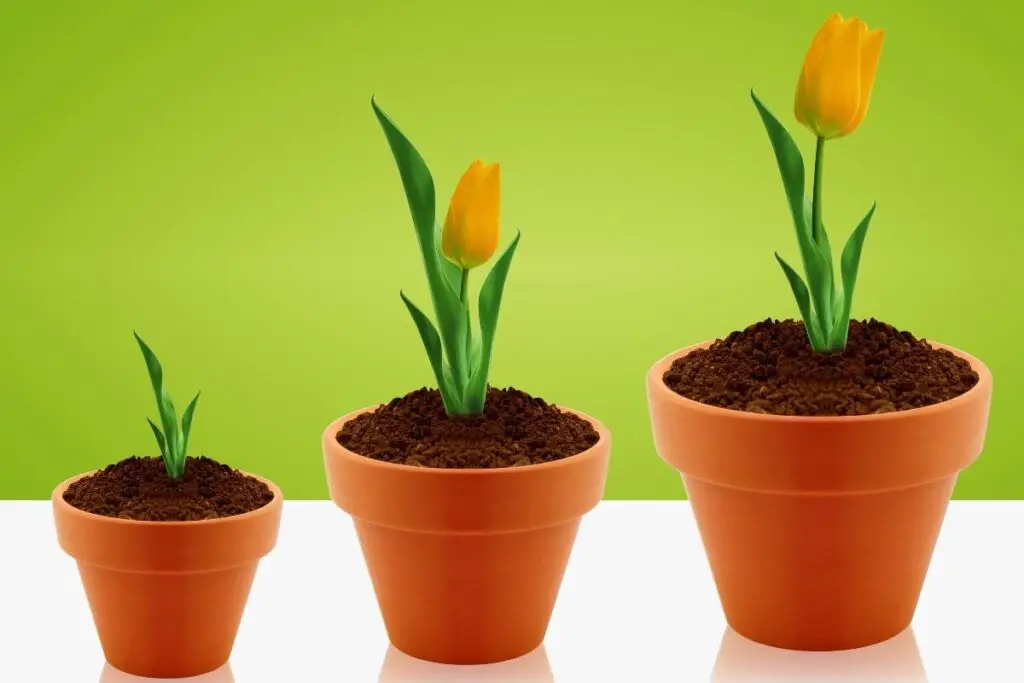
Mulch
Mulch is a usual practice that will help in altering the soil moisture and temperature. But you should be careful while adding it.
Add only 2 inches of mulch to the soil bed. It will also protect your bulbs from rodents.
Excess mulch can absorb all the moisture, whereas too little will not protect them from harsh temperatures.
Don’t cut the leaves until they die.
The leaves will keep gathering energy from the sun until they die, and the bulbs will keep building energy from the leaves. This promotes the bulbs to flower profusely in the next year.
So don’t just immediately cut them after the flower fades or they show browning. Wait until they become yellow, wither, and are completely dead.
Deadheading
Deadheading will also help in more flowering. It will help the plant to concentrate more on the bulbs than forming seedpods.
Divide the bulbs
Overcrowded bulbs will stop the plant from flowering. So, you can dig up the bulb to divide the overcrowded baby bulbs to replant them and grow more tulips.
Before the frost, you can dig up the tulips every 2-3 years during the late summer or fall.
Choose an ideal bulb for better establishment.
Choose varieties that are meant to come back every year. For example, species tulips, Darwin hybrids, and Fosteriana can survive many years compared to other varieties.
Final words
Tulips not flowering is not a big issue until the reason behind the condition is not much serious. With little observation and proper care and maintenance, you can see your tulips growing colorful blooms.
There are many reasons behind this situation. Though you can fix the causes with little effort, prevention is the best way to encourage tulip blooms in your garden.
Now that you got familiar with all the possible reasons behind the cause of tulips not flowering try to avoid these causes and prevent making mistakes. Soon you can see your garden filled with pretty colorful tulips in the first spring.
Source: Wikipedia, North Dakota Stae University, The Royal Horticultural Society.
